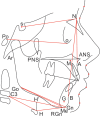Clinical and Cephalometric Correlation between Mouth-breathing and Nasal-breathing Children
- PMID: 41050310
- PMCID: PMC12488522
- DOI: 10.5005/jp-journals-10005-3109
Clinical and Cephalometric Correlation between Mouth-breathing and Nasal-breathing Children
Abstract
Introduction: Pediatric sleep-disordered breathing encompasses conditions from upper airway resistance syndrome to obstructive sleep apnea. Mouth-breathing in children causes severe dentoalveolar deformities. Adenotonsillar hypertrophy exacerbates mouth-breathing, greatly influencing dentofacial development. Early detection of mouth-breathing habit is crucial to prevent the development of malocclusion. Mouth-breathing also alters the salivary pH of the saliva and has an impact on gingival health.
Aim: The study aims to compare and correlate the clinical and cephalometric parameters between nasal-breathing children (NBC) and mouth-breathing children (MBC) among the age-group of 6-12 years.
Materials and methods: A cross-sectional study was conducted to analyze the clinical and cephalometric variables between NBC and MBC among the age-group of 6-12 years who reported to the Department of Pediatric and Preventive Dentistry with the chief complaint of malocclusion. Sixty-six children were assessed for the breathing pattern and categorized into NBC and MBC based on the clinical history and assessment test. After initial screening and examination, the children were referred to the Department of ENT for otolaryngology assessment. Both the groups were assessed for clinical parameters such as malocclusion, salivary pH, tonsillar hypertrophy, and gingival inflammation. Lateral cephalometric assessment was done for both the groups and all the values were tabulated. All the data were analyzed statistically using Statistical Package for the Social Sciences (SPSS) software version 20.
Results: MBC exhibited narrower dental arches (intermolar width: p < 0.001, intercanine width: p < 0.035), increased mouth opening (p = 0.001), and higher tonsillar hypertrophy grades (p < 0.05). Class II molar occlusion was more common among MBC compared to NBC (p = 0.002). MBC (mean = 6.68) also had a reduced salivary pH compared to NBC (mean = 6.36). The maximal mouth opening was also reduced among MBC (p = 0.001). Cephalometrically, MBC displayed a stronger tendency towards skeletal class II occlusion [FMA (p = 0.001)] compared to NBC.
Conclusion: MBC show increased prevalence of malocclusion, tonsillar hypertrophy, gingival inflammation, and decreased saliva pH, impacting dentofacial development, which needs early intervention.
How to cite this article: Balakrishnan P, Srinivasan D, Senthil ARE et al. Clinical and Cephalometric Correlation between Mouth-breathing and Nasal-breathing Children. Int J Clin Pediatr Dent 2025;18(5):514-521.
Keywords: Breathing; Malocclusion; Mouth-breathing; Nasal obstruction; Saliva.
Copyright © 2025; The Author(s).
Conflict of interest statement
Source of support: Nil Conflict of interest: NoneConflict of interest: None
Figures
References
LinkOut - more resources
Full Text Sources
Research Materials
Miscellaneous




